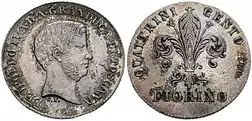Tuscan florin
The Tuscan florin (Italian: fiorino) was the currency of Tuscany between 1826 and 1859. It was subdivided into 100 quattrini (singular: quattrino), a local currency made by four pennies (from the Latin: quater denarii). There was an additional denomination called the paolo, worth 40 quattrini, in circulation.
| Tuscan florin | |
|---|---|
| fiorino (Italian) | |
 One florin by Leopold II | |
| Denominations | |
| Subunit | |
| 1⁄100 | quattrino |
| Symbol | ƒ |
| Coins | q.1, q.3, q.5, q.10, q.20, p.1 ƒ1, ƒ2, ƒ4 |
| Rarely used | ƒ1⁄4, ƒ1⁄2, ƒ20, ƒ60, ƒ80 |
| Demographics | |
| Official user(s) | |
| Unofficial user(s) | |
| Issuance | |
| Mint | Florence Mint |
This infobox shows the latest status before this currency was rendered obsolete. | |
History
During the Napoleonic Wars, Tuscany was annexed by France and the French franc was introduced, together with its satellite Italian lira. Previous Tuscan pound did not disappear, but a big confusion was created between the old pound (called lira in Italian) and the new lira. So, when Duke Leopold II rose to power in 1824, he decided to introduce a new basic currency. The florin replaced the Tuscan pound at a rate of 1 2⁄3 pounds = 1 florin.[1] In 1847, Tuscany absorbed Lucca and the florin replaced the Luccan pound at a rate of 1 florin = 2 pounds. After a brief revolutionary coinage, the florin was replaced in 1859 by a provisional currency denominated in "Italian lira", equal to the Sardinian lira, with 1 florin = 1.4 Italian lire.
References
- Krause, Chester L.; Clifford Mishler (1991). Standard Catalog of World Coins: 1801–1991 (18th ed.). Krause Publications. ISBN 0873411501.
- This fact was quite obvious, because the pound was equivalent to 240 pennies or 60 quattrini, while the florin was equivalent to 100 quattrini or 400 pennies.